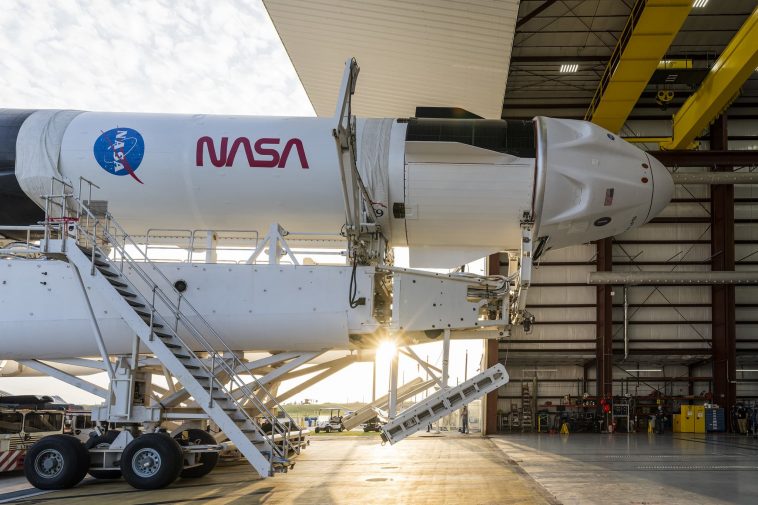The SpaceX's Crew Dragon "Endeavor" atop the company's Falcon 9 rocket exits the SpaceX Integration Hangar next to NASA Kennedy Space Center 39A Launch Complex for launch on April 16, 2021.
SpaceX is set to make history as Elon Musk's Space Company prepares to launch NASA's Crew-2 mission on Friday morning.
NASA and SpaceX have completed a series of reviews ahead of the mission to be launched from Launcher 39A at the NASA Space Center. Kennedy in Florida at 5:49 AM EST on Friday. The launch marks the third launch of the SpaceX crew in the last 12 months, and the first time it fires both a reused rocket and a reused capsule.
“It's nice to be able to do it so quickly. In fact… in less than a year, we partner with NASA to transport as many people as we do on the Mercury program, ”SpaceX Senior Director Benji Reed said at a press briefing earlier this week.
Mercury, launched in 1958, was the first US spaceflight program to launch Alan Shepard as the first American into space. The Mercury program sent six people into space in five years, with a total of SpaceX matching its Demo-2 and Crew-1 missions last year.
The Crew-2 mission will increase the number of SpaceX astronauts to up to a dozen.
"Lots of first, and lots of good things going on," said Reed. "In less than 11 months, a joint NASA and SpaceX team was able to certify the reuse, so we're flying ... NASA astronauts on the flight-proven Dragon and flight-proven Falcon"
"Flying reused, flight proven vehicles is key to greater flight reliability and lower space access costs, which ultimately helps us make life multi-planet," added Reed.
NASA and SpaceX observe the weather, both in the Florida area and in the Atlantic Ocean. The flight had been scheduled earlier for Thursday, but the rough seas delayed the start. The ocean must remain calm in the direction the rocket is launched, in case a mid-flight interruption would result in the capsule splash after take-off.
a little more difficult because this high pressure system is moving over the Arkansas area, which, combined with this front [and], causes fairly strong downward winds in some areas and fairly high waves, ”said Joel Montalbano, NASA's program manager. .
The Crew Dragon capsule needs to meet the ISS in orbit, so if SpaceX doesn't take off on Friday, the company will wait two days until Monday for the next launch opportunity.
SpaceX developed the Crew Dragon spacecraft and tuned its Falcon 9 rocket as part of NASA's Commercial Crew program, which provided the company with $ 3.1 billion to develop the system and launch six operational missions.
The Commercial Crew is a competitive program as NASA has also awarded Boeing $ 4.8 billion contracts to develop the Starliner spacecraft - but this competitive capsule remains in development due to its December 2019 unmanned flight test, which experienced significant challenges.
Crew-2 is the second of these six missions for SpaceX, and NASA is now benefiting from investments made in the development of the company's spacecraft.
NASA emphasizes that in addition to the US being able to send astronauts into space, SpaceX offers the agency a cost-saving option. The agency expects to pay $ 55 million for an astronaut flying with the Crew Dragon, as opposed to $ 86 million for an astronaut flying with the Russians. NASA last year estimated that having two private companies competing for contracts has saved the agency between $ 20 billion and $ 30 billion in development costs.
The company completed a full crew rehearsal for Crew 2 on Sunday, during which a quartet of astronauts practiced dressing in a suit and going to the launch pad in a pair of Tesla Model Xs that SpaceX uses to transport the crew.
Commissioning plan
Four hours before take-off, the astronauts dress. About half an hour later, the crew will go out on Model X rides, bearing the NASA logo, which will travel from the astronaut quarters to the launch pad.
For 2 hours, the astronauts will fit into their seats in the Crew Dragon and begin checking that all systems are working. Then, with less than two hours to take off, the spacecraft's hatch will be closed.
SpaceX will begin loading the rocket with fuel 35 minutes before launch, which will initiate the final series of processes and controls.
A few minutes after take-off, the Falcon 9's boost stage will return and attempt to land on a company's barge stationed in the Atlantic Ocean.
If anything goes wrong in the last half hour before take-off or even during take-off, the Crew Dragon will abort and activate its emergency evacuation system. The company tested this system in January with no one inside the spacecraft. In this test, SpaceX launched the system during the most intense part of take-off to show that it can be done at any time.
Crew-2 is scheduled to dock with the ISS approximately 24 hours later, approximately 5:10 EST on Saturday. Crew-1 Astronauts are still on board, and their Dragon Crew "Resilience" is docked on the ISS. NASA is prepared for the combined crews to spend 5 to 20 days together before Crew-1 returns to Earth.
"Well, have some temporary sleeping arrangements for the crew members because we have so many people," Montalbano said.
Crew-2 will then complete a full mission to the ISS, spending approximately six months on board.




Comments
Loading…